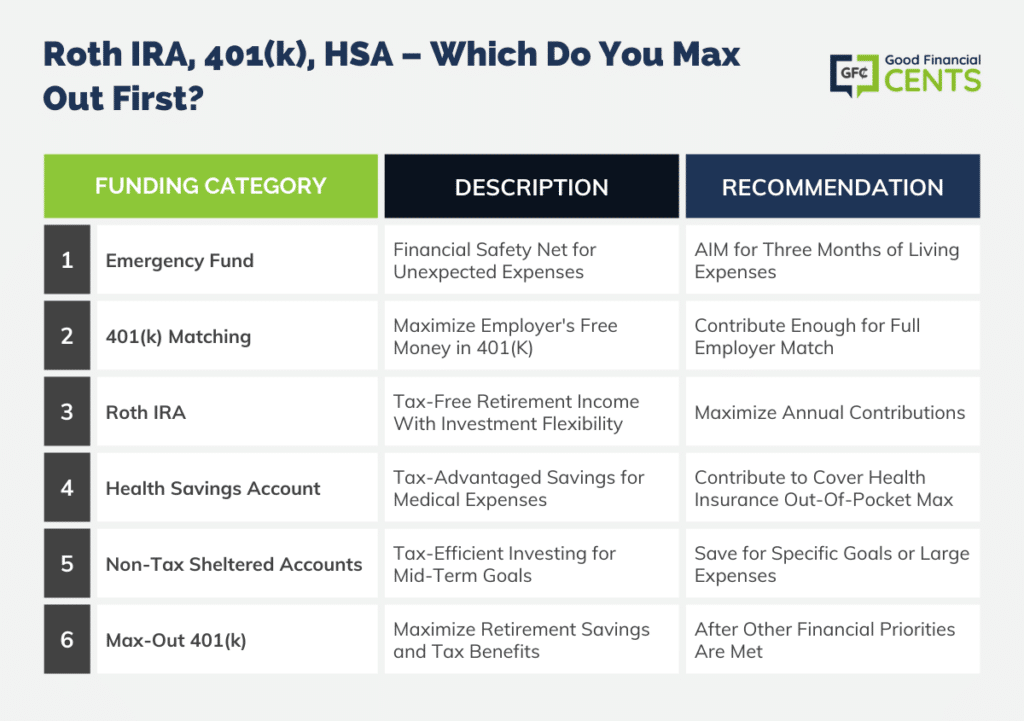Welcome to another Ask GFC! If you have a question that you want answered you can ask it here.
If your questions get featured on GFC TV or the GFC Podcast, you are the lucky recipient of a copy of my best selling book, Soldier of Finance, and a $50 Amazon gift card.
So what are you waiting for? Ask your question now!
This is a question that comes up often, so I’d like to address it. Brian asks:
“What should I be trying to max out first? Roth IRA, 401k, or HSA (pre-tax dollars essentially makes saving an instant 30% return)? Roth IRA and HSA both have easier to reach limits. 401k has a higher limit, and I know it’s common to always put in at least up to your company match. However, I’m not sure how to divide up my remaining excess dollars between the 3 accounts.” – Brian
I’m going to address this question in a general sense based on Brian’s situation.
It may be a little different for each person, depending on the types of plans you have and what perks, if any, your employer provides.
Table of Contents
Here’s the general funding order I’d recommend:
1. Fund an Emergency Fund Before You Do Anything Else
Brian didn’t list this as one of his options, but I’m including it because it is a requirement in most situations.
People often forgo having an emergency fund, making the assumption that if they have enough investment assets, an emergency fund is unnecessary. They may also feel that an emergency fund is a bad investment because the rate of return on supersafe assets is so low.
But an emergency fund is not an investment, and it shouldn’t be judged by the same criteria. It’s generally about having money available just in case. After all, we never know what life has in store, and having some extra cash available is a way of keeping small problems from turning into big ones.
And even though an emergency fund isn’t an investment, it still represents an important part of your investment portfolio. It’s really a form of insurance that protects you from having to tap into your investments when an emergency situation crops up.
For most people, it’s recommended to have something like three months of living expenses in an emergency fund. Starting this fund should be a priority, especially if you are a new or small investor.
2. Fund the 401(k) – At Least Enough to Max Out the Employer Match
Brian mentions this very step in his question, but I’m repeating it for anyone who isn’t familiar with the concept.
If your employer provides a matching 401(k) contribution, you should plan to make the minimum contribution necessary in order to get the maximum employer match. After all, the employer match is virtually found money! You don’t have to do anything special in order to get it other than to make your own contribution to your plan.
So if your employer matches 50% of your contribution, up to a maximum of 10%, then 10% should be your funding target. That will mean that you will effectively be contributing a total of 15% of your income into your 401(k) plan.
To not take advantage of this generous offer is like “leaving money on the table”!
3. The Roth IRA
I’m really sorry to make a Roth IRA contribution #3 on this list, because I love the Roth IRA program and seriously believe that everyone should have one. Not only does it offer the prospect of tax-free income in retirement, but it also has nearly unlimited investment options – certainly more so than the typical employer-sponsored retirement plan.
At a minimum, a Roth IRA should be seen as a form of retirement investment diversification in regard to both income taxes and investment choices.
If your emergency fund is fully funded, and you have contributed up to the minimum that you need to get the maximum employer match on your 401(k), you need to fully commit yourself to maxing out your Roth IRA.
You can contribute up to $7,000 ($8,000 if you’re 50 or older), and your goal should be to maximize the contribution each and every year that you have the money available to do so.
In addition, since contributions to a Roth IRA can be withdrawn free of taxes and penalties for virtually any purpose, I’m putting it ahead of funding HSAs. The limitation on HSAs is that money can be withdrawn from the plan only for qualified medical expenses. You can withdraw funds from your Roth IRA for medical expenses too – and for a whole host of other purposes as well. That makes the Roth IRA the more flexible of the two accounts and the higher funding priority.
4. The Health Savings Account (HSA)
For 2025, you can contribute up to $4,150 to an HSA if you’re single, and up to $8,300 if you have a family. If you’re 55 or older, you can add an additional $1,000 to either limit.
The contributions are fully tax-deductible when made. In a way, this means that you can deduct medical expenses, even if you don’t itemize on your income tax return.
But despite the fact that the contributions are tax-deductible, you don’t necessarily need to go that high.
In general, the contribution should be sufficient to cover the out-of-pocket maximum on your health insurance plan. For example, if your out-of-pocket maximum is $2,500 per person or $5,000 per family, you can cap your contribution at those levels.
The reason for establishing limits based on your out-of-pocket maximum is that, as mentioned above, HSA funds can only be withdrawn for qualified medical expenses.
If you don’t use them in a given year, you can roll them forward, but the ultimate purpose must be medical-related.
5. Curveball: Fund Some Non-tax Sheltered Accounts!
This is another funding priority that Brian didn’t mention in his question, but one that I recommend that you consider carefully.
In addition to your tax-sheltered investment plans, adding non-tax-sheltered investments can help you to save and invest for intermediate-term goals. They may be goals that are more than five years into the future but fall short of retirement planning. This can include investing money for a specific purpose, such as your children’s college educations, or for general large outlays, such as replacing your car and the roof of your house.
There can also be an important tax angle here. If you are in the 10% or 15% income tax bracket, you may be subject to 0% capital gains tax. That means that you can invest in appreciating assets without having to pay taxes on the gains. And then you can withdraw the money at any time without any tax consequences.
6. Last: Max-Out Your 401(k)
When all of the above priorities have been met, it’s time to look at maxing out your 401(k) contribution. This will not only maximize the amount of money that you will have available for retirement, but it will also give you a great big tax deduction.

Final Thoughts
I mentioned at the beginning that this advice is general and that it will change a bit for each person depending upon their circumstances.
Some situations where you might consider changing the priorities could include:
- You’re close to retirement, so you should want to max out your 401(k) contribution ahead of funding non-tax-sheltered investments.
- You may decide that you want to make funding non-tax sheltered investments and maxing out your 401(k) a simultaneous priority. For example, you may decide to split contributions to each on a 50/50 basis or whatever split you decide on.
- If you have high medical costs due to a chronic condition or illness, you might want to move to fund your HSA ahead of your Roth IRA.
- If most of your assets are in retirement plans, you may want to give greater priority either to non-tax-sheltered investments or to a Roth IRA.
These are just some examples of funding priority variations. If you’re unsure what priority to use, discuss it with your financial advisor.








Great article and you make a great point about the flexibility of the Roth IRA to take out contributions at any time- I think of this as the last case backup to the emergency fund. Bucket system of savings where once the emergency account is funded, you are free to choose to increase 401k, contribute to Roth, or HSA.
I am 30 years old married with three kids. We keep 15k in emergency, have about 30 in Roth (backup emergency), and will be maxing out the $6,750 in my wife’s HSA from now on before maxing out Roth. The reason being is that after age 65, you can withdraw from your HSA for any reason without a 20% penalty- you just have to pay income tax on the earnings like a 401k or traditional IRA. Bottom line is that I believe maxing out your Roth IRA for a few years before switching your focus to the HSA next. HSA gives you a tax break on federal, state, and Medicare and Social Security tax where 401k is JUST tax break on federal and state.
Please let me know if I’m missing something here or you have other viewpoints from my situation where I have 30+ years til retirement and are looking at as much tax breaks now.
Hi David – I think that’s a good strategy. With healthcare costs rising, and the fact that you can no longer contribute to an HSA once you start Medicare, you’ll be able to use the HSA either for medical expenses or for retirement. In the meantime it’ll cover out-of-pocket medical costs, and with three kids that isn’t a bad option to have either. I’d say you’re thinking right.
I max out my Roth IRA first every year knowing that I will also be able to max out my 401(k) up to the match at least. If I had to choose, I would definitely pick the 401k(k) first. I invest in a Roth 401(k) as well not to mention I also max out my HSA now.
That’s an excellent strategy. I usually recommend maxing out the 401k up to the match first, which I did in the article. But in your case you’re doing that in addition to the Roth IRA. It isn’t critical to do it in order if you plan to do both. The priority is mostly for those who might be able to do one but not necessarily the other.
Yes 401K to match first…. But most employers match an HSA, too. And nearly all of us will get sick and need care before retirement. And if you become unemployed you can use the tax free HSA funds to pay your premiums. And so far, YOU NEVER PAY TAX on your HSA unless you withdraw it for something other than health expenses. What other tax sheltered, portable, year on year rollover account do you NEVER PAY taxes on? No other account. So my method is 401K to match, HSA and then Roth.